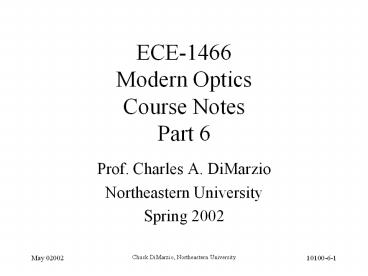ECE-1466 Modern Optics Course Notes Part 6 - PowerPoint PPT Presentation
1 / 15
Title:
ECE-1466 Modern Optics Course Notes Part 6
Description:
1 Candela=1cd=1L/sr. Irradiance. Watts/m2. Illuminance. Lumens/m2=Lux. 1 Ft Candle=1L/ft2. Notes: Spectral x=dx/dn or dx/dl: Add subscript n or w, divide units by ... – PowerPoint PPT presentation
Number of Views:89
Avg rating:3.0/5.0
Title: ECE-1466 Modern Optics Course Notes Part 6
1
ECE-1466Modern OpticsCourse NotesPart 6
- Prof. Charles A. DiMarzio
- Northeastern University
- Spring 2002
2
Lecture Overview
- Some Radiometry
- Terminology
- Equations Relating Radiometric Parameters
- Photometric Parameters
- Some Numbers
- A Little Bit of Scattering Theory
- Some Applications in Microscopy
3
Radiometric Quantities
4
Radiometry and Photometry
M, Flux/Proj. Area
Notes Spectral xdx/dn or dx/dl Add subscript n
or w, divide units by Hz or mm.
F, Flux
Radiant Flux Watts Luminous Flux Lumens
Radiant Exitance Watts/m2 Luminous
Exitance Lumens/m2Lux
1 W is 683 L at 555 nm.
Radiance Watts/m2/sr Luminance Lumens/m2/sr 1
Lambert (1L/cm2/sr)/p
I, Flux/W
L,Flux/AW
Radiant Intensity Watts/sr Luminous
Intensity Lumens/sr
E, Flux/Area Rcd.
Irradiance Watts/m2 Illuminance Lumens/m2Lux
1 ftLambert (1L/ft2/sr)/p 1mLambert (1L/m2/sr)/p
1 Ft Candle1L/ft2
1 Candela1cd1L/sr
5
Luminance and Radiance
1.8
This curve shows the relative sensitivity of the
eye. To convert to photometric units from
radiometric, multiply by 683 Lumens Per Watt
y
1
Photopic Sensitivity
0
400
500
600
700
800
Wavelength, nm
6
Radiance in Images
dA2
dA
dA1
dW2
dW1
z
7
Typical Radiance Levels
Our Example 0.0037/p W/m2/sr 0.001 W/m2/sr at
f/1
Half-Lux Camera 0.0044 W/m2/sr
8
Black-Body Equation (1)
9
Black Body Equations (2)
10000
5000
2000
500
1000
T300k
10
Solar Irradiance on Earth
Data from The Science of Color, Crowell, 1953
3000
Exoatmospheric filenamem1695.m
Sea Level
2
5000 K Black Body Normalized to 1000 W/m
2500
2
6000 K Black Body Normalized to 1560 W/m
m
m
/
2
2000
1500
, Spectral Irradiance, W/m
1000
l
E
500
0
0
200
400
600
800
1000
1200
1400
1600
1800
2000
l
, Wavelength, nm
11
Tungsten Lamps Hot is Good!
- 3000 K
- 20 Lumens per Watt
- lpeak1.22mm
- x .4357y .4032 z .1610
- 3400 K note (3400/3000)41.64)
- 34 Lumens per Watt note 20X1.6433
- lpeak1.09mm
- x .4112y .3935 z .1953
y
x
12
Quartz-Halogen Lights
- Tungsten Filament
- Higher Temperature Brighter, Whiter
- Requires Quartz Envelope
- Tungsten Evaporates More Rapidly
- Halogen Catalyst
- Prevents Tungsten Deposit on Hot Envelope
- Tungsten Redeposits on the Filament
- Evaporation and Redeposition Requires Thicker
Filament - Lower Resistance Requires Lower Voltage
13
Lighting Efficiency
1000000
Fluorescent
94 Lumens/Watt at 7000K (Highest Efficiency Black
Body)
Hi Pressure
Na
Metal Halide
100000
Lo Pressure
Na
Incandescent
10000
Light Output, Lumens
Thanks to John Hilliar (NU MS ECE 1999) for
finding lighting data from Joseph F.
Hetherington at www.hetherington.com. 10 June 1998
1000
20.7 Lumens/Watt at 3000K
100
10000
1
10
100
1000
Power Input, Watts
14
Source Intensity
0.142 W
- Fraction of Light in Filter Passband
- Given by Black-Body Equation
- Numerical Calculation is Easiest
100W
Black Body Spectral and Integrated Flux Density
Rev 2.17 by Chuck DiMarzio, Northeastern
University 1992,1993,1995, 1997 .49600
to .50400 micrometers, T 3000.0
K Maximum Spectral Radiant Exitance
.81762E06 W/m2/micron in band
Radiant Exitance in Band 6541.5
Watts/m2 Wide Band Radiant
Exitance .45925E07 Watts/m2
Fraction of total in band
.14244E-02 Spectrum on bbsre.dat
Photocurrent per
Area in Band 2669.5
Amps/m2
.16663E23 photons/sec/m2
Average Responsivity .40808
Amps/Watt
.39257E-18 Joules/photon (in band) ...
15
Incident Irradiance
- Mostly a Geometric Problem
- G describes non-uniformity
- Like Antenna Gain
Distance R
E GP/(4pR2)
Power P
E (1?)0.14 W/4p(0.3)m2 0.12 W/m2
Comparable to a dark cloud































